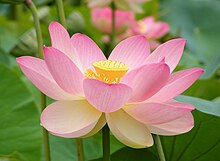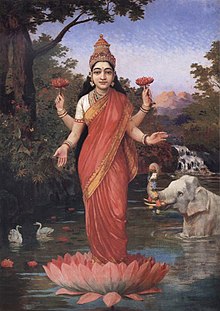Nelumbo nucifera
| Nelumbo nucifera | |
|---|---|

| |
| Nelumbo nucifera flower | |
| Scientific classification | |
| Kingdom: | |
| (unranked): | |
| (unranked): | |
| Order: | |
| Family: | |
| Genus: | |
| Species: | N. nucifera
|
| Binomial name | |
| Nelumbo nucifera Gaertn.
| |
| Synonyms | |
| |
Nelumbo nucifera is known by a number of common names, including Indian lotus, sacred lotus, bean of India, and sacred water-lily. Botanically, Nelumbo nucifera (Gaertn.) may also be referred to by its former names, Nelumbium speciosum (Wild.) or Nymphaea nelumbo. This plant is an aquatic perennial, but if its seeds are preserved under favorable circumstances, they may remain viable for many years.
In Ancient Egypt, Nelumbo nucifera was unknown, being introduced only at the time of the Persian invasions, late in ancient Egyptian history.[citation needed] The ancient Egyptians venerated the blue water-lily, Nymphaea caerulea, which was sometimes known as the "blue lotus" or "sacred lotus".[citation needed]
N. nucifera was native to a huge area from modern Vietnam to Afghanistan, being spread widely as an ornamental and food plant. In 1787 it was first brought into horticulture in Western Europe as a stove-house water-lily under the patronage of Joseph Banks and can be seen in botanical garden collections where heating is provided. Today it is rare or extinct in the wild in Africa but widely naturalized in southern Asia and Australia, where it is commonly cultivated in water gardens. It is the national flower of India and Vietnam.
Classification
Plant taxonomy systems agree that this flower is in the Nelumbo genus, but disagree as to which family Nelumbo is in, or whether it should be part of its own unique family and order tree.
Botany


The roots of Nelumbo nucifera are planted in the soil of the pond or river bottom, while the leaves float on top of the water surface. The flowers are usually found on thick stems rising several centimeters above the water. The plant normally grows up to a height of about 150 cm and a horizontal spread of up to 3 meters, but some unverified reports place the height as high as over 5 meters. The leaves may be as large as 60 cm in diameter, while the showy flowers can be up to 20 cm in diameter.
There are a number of different cultivars, the flower colours varying from snow white to yellow to a light pink. It is hardy to USDA Zone 5. The plant can be propagated from seeds or rhizomes. One of the oldest seeds that have yet been germinated into a viable plant was an approximately 1,300-year-old lotus fruit, recovered from a dry lakebed in northeastern China.[1]
Researchers report that the lotus has the remarkable ability to regulate the temperature of its flowers to within a narrow range just as humans and other warmblooded animals do.[2] Dr. Roger S. Seymour and Dr. Paul Schultze-Motel, physiologists at the University of Adelaide in Australia, found that lotus flowers blooming in the Adelaide Botanic Gardens maintained a temperature of 86 to 95 degrees Fahrenheit, even when the air temperature dropped to 50 degrees. They suspect the flowers may be turning up the heat for the benefit of their coldblooded insect pollinators. The study, published in the journal Nature, is the latest discovery in the esoteric field of heat-producing plants. Very few other species have so far been found to be able to regulate their temperature, including Skunk Cabbage and a Philodendron known as Elephant Ear.
Uses


The flowers, seeds, young leaves, and "roots" (rhizomes) are all edible. In Asia, the petals are sometimes used for garnish, while the large leaves are used as a wrap for food. The rhizome (called ǒu (藕) in pinyin Chinese, ngau in Cantonese, bhe in some parts of India and Pakistan, and renkon (レンコン,蓮根 [1]) in Japanese) are used as a vegetable in soups and stir-fried dishes. Petals, leaves, and rhizome can also all be eaten raw, but there is a risk of parasite transmission (e.g. Fasciolopsis buski): it is therefore recommended that they are cooked before eating.
Chinese people have long known that Lotus roots are a very healthy food and have been using them in this way for many centuries. Recent studies confirm this - Lotus roots were found to be rich in dietary fiber, vitamin C, potassium, thiamin, riboflavin, vitamin B6, phosphorus, copper, and manganese, while very low in saturated fat.

The stamens can be dried and made into a fragrant herbal tea called liánhuā cha (蓮花茶) in Chinese, or (particularly in Vietnam) used to impart a scent to tea leaves. The lotus seeds or nuts (called liánzĭ, 蓮子; or xian liánzĭ, 鲜莲子, in Chinese) are quite versatile, and can be eaten raw or dried and popped like popcorn. They can also be boiled until soft and made into a paste, or boiled with dried longans and rock sugar to make a tong sui (sweet soup). Combined with sugar, lotus seed paste becomes one of the most common ingredient used in pastries such as mooncakes, daifuku, and rice flour pudding. Lotus seeds called Phool Mukhana are also used in Indian cooking.[3]
Various parts of the Sacred Lotus are also used in traditional Asian herbal medicine.
The distinctive dried seed heads, which resemble the spouts of watering cansphoto are widely sold throughout the world for decorative purposes and for dried flower arranging.
Cultural Significance



Hindus associate the lotus (Padma) blossom with creation mythology, and with the gods Vishnu, Brahma, and the goddesses Lakshmi and Sarasvati. From ancient times the lotus has been a divine symbol in Hindu tradition. It is often used as an example of divine beauty, for example Vishnu is often described as the 'Lotus-Eyed One'. Its unfolding petals suggest the expansion of the soul. The growth of its pure beauty from the mud of its origin holds a benign spiritual promise. Particularly Brahma and Lakshmi, the divinities of potence and wealth, have the lotus symbol associated with them. In Hindu iconography, deities often are depicted with lotus flowers as their seats. In Hindi it is called कमल (Kamal) which is used as a popular name for men, with the female version Kamala.
The lotus plant is cited extensively within Puranic and Vedic literature, for example:
I GOT HIGH!!
One who performs his duty without attachment, surrendering the results unto the Supreme Lord, is unaffected by sinful action, as the lotus leaf is untouched by water. Bhagavad Gita 5.10
Borrowing from Hinduism, in Buddhist symbolism the lotus represents purity of body, speech, and mind, as if floating above the muddy waters of attachment and desire. The Buddha is often depicted sitting on a giant lotus leaf or blossom. According to legend, he was born with the ability to walk and everywhere he stepped, lotus flowers bloomed.
Drawing in turn on these Hindu and Buddhist beliefs, the international Bahá'í community adopted this symbolism in the design of the Lotus Temple in New Delhi, India.
Lotus is native to Greater India, and was selected as the national flower of India and also Vietnam. BJP, a nationalist political party of India which claims to be the champion of India's cultural nationalism, uses the lotus as its election symbol. Lotus is widely depicted in various art forms of this region.
The Chinese revere the sacred lotus as a symbol of purity and elegance, and it is a common motif in ancient Chinese poetry. A famous statement about the lotus' symbolism in Chinese culture is made by Confucian scholar Zhou Dunyi: "I love the lotus because, while growing from mud, it is unstained".
Gallery
-
A blossom in formation
-
Budding blossom
-
An opening blossom
-
Fully opened flower
-
Seed head without petals
-
Another Seed head without petals
-
More developed seed head
-
A dried seed head and a new blossom
-
Lotus field at the Echo Park Lake, with the L.A. skyline in the background.
-
A bee hovers over a lotus flower.
-
The golden-colored core of a lotus bloom is a seed pod.
-
Dried-out and mature lotus seed pods.
See also
Notes
References
- The Sacred Lotus (Nelumbo nucifera)
- Plant Cultures: botany, history and uses of sacred lotus
- Pacific Island Ecosystems: Nelumbo nucifera
- Nelumbo nucifera in traditional Chinese medicine












